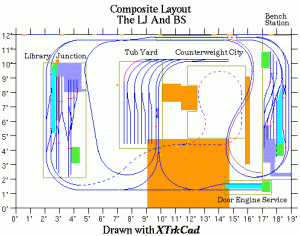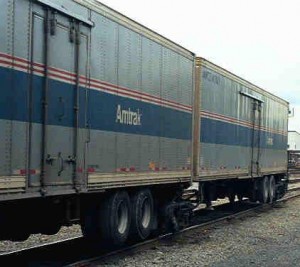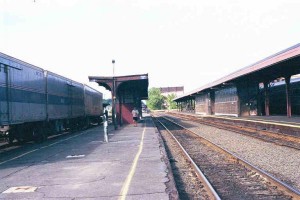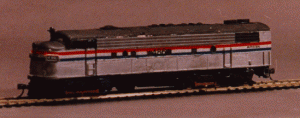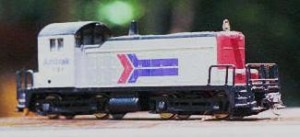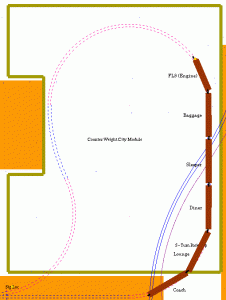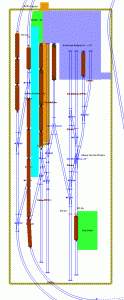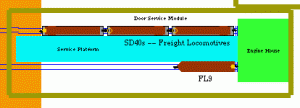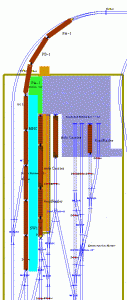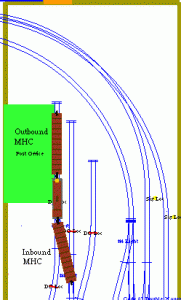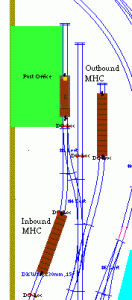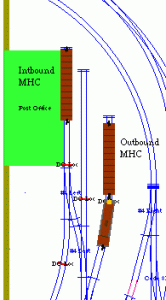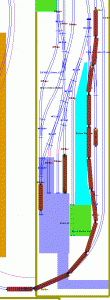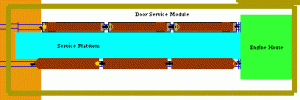Robert Heller
July 30, 2000
Abstract
This is a narrative that explains the concept ideas behind this "free lance" model railroad. It also describes the planned timetable and activities of the main trains and yard activities that will run on this railroad, once it has been completed.
Table Of Contents:
2 Sources of ideas: riding Amtrak’s The Lake Shore Limited
3 Additional ideas: Amtrak’s Auto Train
4 The places of the LJ and BS Railroad
5 The power of the LJ and BS Railroad
6 The rolling stock of the LJ and BS Railroad
7 Take a ride on the LJ and BS Railroad, do pass GO!
7.1 At Counterweight City
7.2 At Library Junction
7.3 At Bench Station
7.4 Returning to Library Junction
7.5 Returning to Counterweight City
List Of Figures:
2 RoadRailers on the tail end of the eastbound Lake Shore Limited.
3 RoadRailers Springfield, MA.
4 One of my kit-bashed FL9’s painted in Amtrak Phase III.
5 Some of my Alco passenger locomotives.
8 Train at Counterweight City, first stop.
9 Train at Library Junction, with engine uncoupled.
10 FL9 at Door Engine Service, being re-fueled, etc.
11 Train at Library Junction, with Alco ABA engine set, pulled up.
12 Train at Library Junction, waiting for clearance to go.
13 Train at Bench Station, freight dropped behind the turnout.
14 Train at Bench Station, repositioned and after the switcher has picked up the tail end "freight".
15 Switcher has dropped off the RoadRailer and is about to drop off the Auto Carrier.
16 Switcher has dropped off the Auto Carrier and is picking up the outbound MHC.
17 About to run around the inbound MHC.
18 Shoved the inbound MHC onto the post office siding and now picking up the outbound MHC.
19 After picking up the outbound Auto Carrier and about to pick up the outbound RoadRailer.
20 Switching done, ready to reassemble the train.
22 Returning to Library Junction, with the Alco ABA set uncoupled.
23 Short wait at Library Junction for passenger and baggage exchange.
24 The Alco ABA set at Door Engine Service being re-fueled and serviced.
1 Introduction
The The LJ and BS Railroad1 is a H0 (1:87) model railroad that is presently a "work in progress". It consists of 5 "modules" suspended about 12" from my ceiling, with addition trackage mounted on wall brackets or independently suspended from the ceiling. See Figure 1. I have opted for this approach, since I don’t have available floor space — the only "free" space it up near the ceiling, space that is generally under utilized. I have been working on this project on and off for several years, slowly acquiring the pieces and making what needs to be made.
2 Sources of ideas: riding Amtrak’s The Lake Shore Limited
A large part of the inspiration for this model railroad came from riding Amtrak’s The Lake Shore Limited between Springfield, MA and Rochester, NY. I make this trip two or three times a year to visit family in the Rochester, NY area: my mom, my brother David, my sister Susan, my brother-in-law Chris, and my niece Celeste. I always take the train — it is a relaxing and always interesting ride.
One of the more interesting features of this train is the fact that it is really two trains. Westbound it is Amtrak train number 49 from New York City to Chicago and Amtrak train number 449 from Boston to Chicago. These two trains join and become the 49/449 at Albany-Rensselaer, NY. Eastbound this train starts as 48/448 in Chicago and becomes two trains, Amtrak train number 48 from Chicago to New York City and Amtrak train number 448 from Chicago to Boston at Albany-Rensselaer, NY. For awhile the westbound Boston section (449) brought a string a MHCs2 from Boston to Springfield, MA, to be carried south on a latter train. More recently this train has gotten a string of RoadRailers3 from Springfield, MA to Chicago. See Figures 2 and 3. I have found the switching that is involved in this train, at Springfield, MA and Albany-Rensselaer, NY to be an interesting and entertaining part of my trips on this train. The LJ and BS Railroad incorporates some of these features and activities.
3 Additional ideas: Amtrak’s Auto Train
Although I don’t have a car and have never ridden on Amtrak’s Auto Train, the idea is itself also very fascinating and something I would like to model. There was an article in the May, 2000 issue of Model Railroader magazine by John McKeeman (page 66) about Amtrak’s Auto Train terminal at Lorton, Va. I found this article very interesting. I incorporated some of the ideas presented in this article.
4 The places of the LJ and BS Railroad
The LJ and BS Railroad consists of five bench-work quot;modules":
- Library Junction.
At the "northwest" end of the layout (in reality this is the southeast end of the room) is Library Junction. This is a 3′ by 8′ module that is over my large science fiction library. In terms of The LJ and BS Railroad, this is the "west" RoadRailer, mail, and Auto Train terminal. This is also a crew change and engine change point as well.
- Tub Yard.
The next module to the "east" of Library Junction is Tub Yard. Tub Yard is a freight classification yard, with 8 class tracks and a RIP4 track. This module is located over my bathtub. This is a 3′ by 6′ module. To conserve space I "bent" the yard ladder.
- Counterweight City.
Continuing east, we come to Counterweight City. This 4′ by 5′ module is notched to accommodate the counterweight for my heavy trap door. The trackage here is underground, much like the trackage in NYC on the island of Manhattan. It also has a passenger rail station with below the street trackage, much like Penn. Station in NYC.
- Bench Station.
The "easternmost" module is Bench Station. This 2′ by 10′ module is suspended over my workbench. This is the "east" RoadRailer, mail, and Auto Train terminal.
- Door Engine Service.
"South" of Bench Station and slightly "west" is Door Engine Service. This small 3′ by 1′ module is a re-fueling and general engine service area. There are two service tracks and a small engine house.
In addition to the modules, there is a 400 scale foot Warren type through truss bridge that spans over a 4′ window. There is a broad S-curve between Counterweight City and Bench Station that rises slightly to arch over my workbench light. There is the S-curve tunnel connecting Library Junction and Counterweight City. There is a freight connection line between the "northern" mainline and the south end of Tub Yard. There is also a reversing wye connecting Library Junction, Tub Yard, and Door Engine Service.
5 The power of the LJ and BS Railroad
The primary interest on the LJ and BS Railroad is the passenger trains, so most of the locomotives are painted with Amtrak colors. Because of the long, poorly ventilated tunnel and underground station at Counterweight City, I am using dual power locomotives on this section: EMD FL-9 locomotives. See Figure 4. I have two of these, both kit-bashed from Atlas FP-7s.
For the main road power between Library Junction and Bench Station I will be using ABA sets of Alco passenger locomotives5. See Figure 5.
For yard work at Library Junction and Bench Station, I have a pair of EMD SW1 locos in Amtrak Phase I. See Figure 6.
For the main line freight power I plan on getting some SD40s and for yard work at Tub Yard, I plan on creating a mother-daughter set consisting of an SD38 and a 6 axle yard slug.
6 The rolling stock of the LJ and BS Railroad
I will be using 72′ passenger cars6, mostly Athearn, with one ConCor sleeper. I plan on modifying one of the Athearn coaches into a "food service" car, since this type of car does not appear to be generally available. I already have a set of three auto carriers (see Figure 7) and will be getting a set of three Bowser RoadRailers and a set of three ConCor MHCs.
For the freight side of things I’ll probably get an assortment of freight cars.
7 Take a ride on the LJ and BS Railroad, do pass GO!
7.1 At Counterweight City
An end-to-end ride on the LJ and BS Railroad starts at Counterweight City. The train consist is as follows:
- FL9 Engine.
- Baggage.
- Sleeper.
- Diner.
- Lounge (food service car).
- Coach.
First the baggage is loaded, the sleeper car passengers boarded, and the diner is stocked. See Figure 8.
Once the baggage, sleeper, and diner are settled, the train moves up and the lounge is stocked and the coach passengers are boarded. The train then travels counter-clockwise under Counterweight City and enters the tunnel on its way to Library Junction.
7.2 At Library Junction
Arriving at Library Junction the train stops and the FL9 locomotive is uncoupled from the train and pulled past the turnout. See Figure 9.
The FL9 is run in reverse down to Door Engine Service for re-fueling, inspection, and other servicing. See Figure 10. The waiting Alco locomotive ABA set is switched to the station track and coupled up to the train. The train is then pulled up until all of the cars are up to the station platform. See Figure 11. Then the SW1 switcher pulls back and shoves the MHC, Auto Carrier, and RoadRailer onto the rear of the train and uncouples itself. See Figure 12. After a brake test the train is now ready to go. It waits for clearance from the station master and the dispatcher, then leaves for Bench Station.
7.3 At Bench Station
When the train arrives at Bench Station it takes the platform siding and drops off the "freight" before the turnout — the station switcher will pick these cars up shortly. Meanwhile, because of the wait here and because of the length of the train and the short platform, the train is split between the sleeper and diner. See Figure 13.
After positioning the front half of the train on the second station platform, the station switcher picks up the tail end "freight". See Figure 14. The switcher first drops off the RoadRailer and then prepares to drop off the Auto Carrier, as shown in Figure 15. After dropping off the Auto Carrier, the switch heads off to collect the outbound MHC waiting at the post office siding. It still has the inbound MHC in tow. See Figure 16. After picking up the outbound MHC, the switcher moves it to an adjacent track so it can place the inbound MHC at the post office siding, as shown in Figures 17 and 18. After placing the the inbound MHC at the post office siding, the switcher does a run around move to swap ends with the outbound MHC, and then goes and picks up the outbound Auto Carrier and prepares to pick up the outbound RoadRailer, as shown in Figure 19.

After picking up the outbound RoadRailer, the switcher positions the "freight" behind the station platform turnout and uncouples itself, as shown in Figure 20. Now the road power will reassemble the complete train (while the switcher was busy moving the "freight" around, the road engines has been fueled and passengers have detrained and boarded, and baggage has been unloaded and loaded. After reassembling the train, it how waits at the yard limit signal waiting for clearance from the station master and the main line dispatcher and shown in Figure 21.
7.4 Returning to Library Junction
Upon returning to Library Junction, the Alco ABA set is uncoupled so the FL9 can be recoupled to the train, as shown in Figure 22. The FL9 brings the train the rest of the way into the station and the "freight" is decoupled. There is a short wait while detraining passengers detrain and passengers bound for Counterweight City board, as shown in Figure 23. Baggage bound for Library Junction is unloaded and baggage bound for Counterweight City loaded. The passenger cars also have their water tanks toped off as well. The Alco ABA set travels to Door Engine Service to be re-fueled and serviced, as shown in Figure 24.
7.5 Returning to Counterweight City
Once the passenger cars also have been watered and the passenger and baggage exchange has completed the train returns to Counterweight City. While the train is en-route to Counterweight City the Library Junction switcher does a similar "dance" as the Bench Station switcher did — the tail end cars are swapped with their corresponding cars waiting at Library Junction and the switcher waits with the outbound string for the train to return from Counterweight City. The Alcos are serviced and turned and also return to Library Junction to await the train’s return from Counterweight City.
1: The Library Junction and Bench Station Railroad, named for the two major terminals on the line.
2: Material Handling Cars — 60 foot express box cars.
3: Special highway semi-trailers designed to work with special bogies and be carried by rail.
4: Repair In Place.
5: I know, Amtrak never had any of these locomotives, but this is a free lance model railroad and I like how these locomotives look.
6: These are not prototypical, but because of limited space and the tight curves under Counterweight City, I need to use these "shortened" cars.

